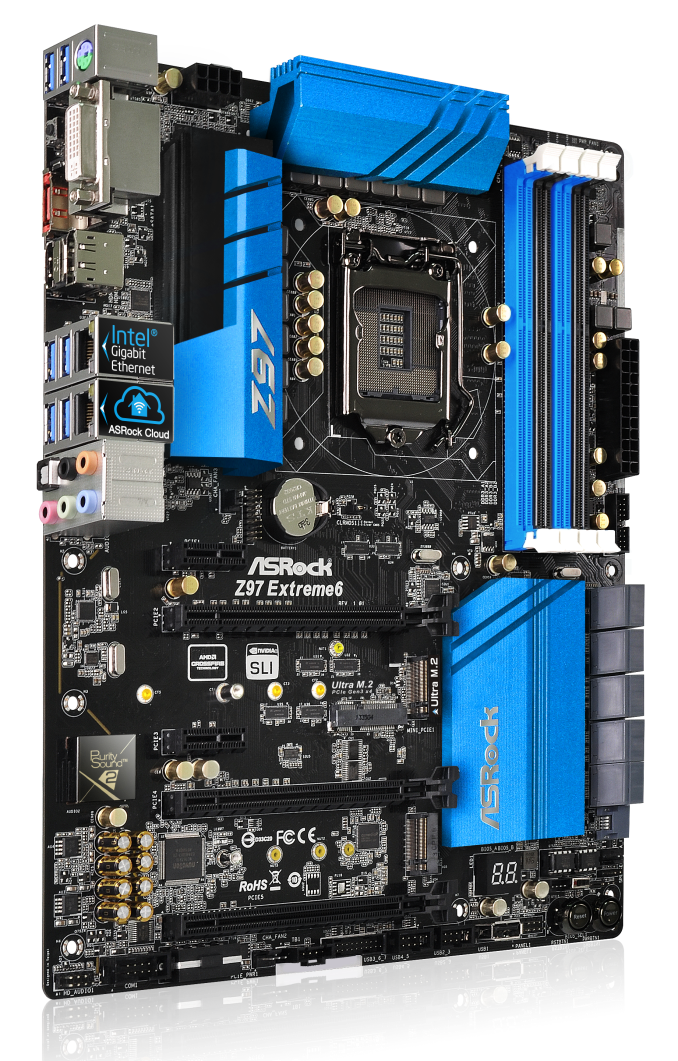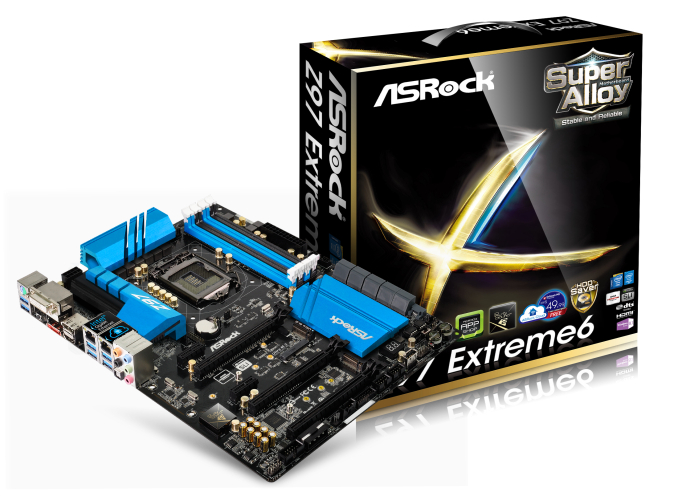ASRock Z97 Extreme6 Review: Ultra M.2 x4 Tested With XP941
by Ian Cutress on May 24, 2014 12:00 PM ESTASRock Z97 Extreme6 Conclusion
The big talking point for ASRock’s launch was the inclusion of that “Ultra M.2”, an M.2 x4 slot drawn off the CPU PCIe lanes. This is what I like to characterize as an ‘ASRock Jump’, a characteristic of ASRock to try new and different things. Some work, some do not, and others become part of the ASRock fold. I am glad that they have shown the M.2 x4 is a plausible asset to have, but unfortunately, like SATA Express, the main issue is having the hardware on the market to take advantage of it. The current M.2 drives on the market are mostly SATA based and not PCIe, and if they are to be PCIe they are most likely PCIe x2. Luckily we had an XP941 512GB, an OEM PCIe x4 SSD in to test with our review.
The two M.2 slots on the Z97 Extreme6 showed the effect of the PCIe x4 device when restricted by x2 lanes and allowed to stretch its legs with x4. With peak sequential results pointing to a +50% speed-up rather than a 3.2x that the lane bandwidth suggests, this gives SSD manufacturers more headroom to work with, and users faster drives. Although when the M.2 x4 is in use it brings the PCIe bandwidth of the first two slots down frame rates are not adversely affected at 1080p Max on our small test of a few modern titles. The major downside is that using the M.2 disables SLI, which is more a result of NVIDIA’s restriction for 8 lanes per GPU. So while the lack of drives on the market makes this almost a non-feature until later this year, it does set a very interesting precedent for other motherboard manufacturers (as well as ASRock) when they become more prevalent, or for a series of limited-GPU derived products that can siphon lanes into storage.
The specialist feature aside, the motherboard still has access to 10 SATA ports (some shared), 10 SATA USB 3.0 ports (using a controller and a hub) and enhanced Realtek ALC1150 sound. The vertical USB 2.0 port carries over from last generation and server builds, useful for verification dongles or any device that needs to be in the system permanently and away from small children at the back of the system. Next to this is a new feature called HDD Saver which, by using the cable in the box, can provide power to two SATA devices. These devices can be enabled and disabled via software in the OS, allowing users to create backups, save power or hide data from electronic attacks. The network capabilities stretch to two Ethernet ports, one Intel I218-V and one Realtek 8111GR.
The ASRock BIOS now has a Full HD mode allowing for 1920x1080 resolutions which also work on higher resolution monitors (although not by default). The color scheme of the BIOS has changed to match that of the motherboard, and in my eyes has lost some of the appeal of the last generation as the graphical icons are replaced with text. Much of the feature-set of the BIOS is the same as Z87 except for added options such as HDD Saver and My Favorites, accessible from the Main tab. The OC Tweaker tab is a single list of options that has now got too long, and ASRock should consider partitioning it up into separate menus. The software utilities now include the ASRock App Shop, an interface to download ASRock approved software and games as well as new BIOSes and drivers, and the Disk Monitor to give information about SATA devices installed.
In terms of performance, the ultra-low DPC Latency broke a new record (it has now been broken twice in two reviews) and the ASRock has plenty of automatic overclock options to keep everyone happy. Our overclocking test gave 4.6 GHz with our i7-4770K, limited by the temperature but in line with other motherboards we have tested. The initial POST time is a little long, a characteristic shared between many of the Z97 launch motherboards, however when controllers are disabled this moves down to below seven seconds.
For $170, there are going to be few motherboards that can boast 10 SATA ports and 10 USB 3.0, with access to multi-GPU configurations or an M.2 x4 slot. If we include the dual NICs and enhanced audio in that assessment, then it is plausible that one of the things missing is 802.11ac support, although users can add their own with the mini-PCIe integrated onboard. It makes me wonder why ASRock did not release a WiFi version of this motherboard. As with the other manufacturers, the biggest barrier ASRock has with the Z97 Extreme6 is that it uses storage features that have no products on the market, so users are buying into future possibilities with no guarantee which way the market will shift.
I am glad of the M.2 x4 being here, showing that it can be done and that this is the future. However it is hard to recommend a feature that cannot yet be exploited due to lack of product on the market. Given that ASRock has a history of making crazy storage options with their Extreme11 moniker, and there is no Z97 Extreme11 yet listed, I kind of want them to use a PLX chip and siphon off 16 lanes into a four M.2 x4 drive bay or something equally as ‘extreme’. I hope to see something like that (or this) at Computex. But again, we would have to await the drives to actually come to market.












43 Comments
View All Comments
Haravikk - Sunday, May 25, 2014 - link
Once again I can't understand this over-subscription that results in complex balancing of which SATA ports are used. I mean really, how many people buying these types of motherboards actually need more than four SATA ports? How many actually need a full seven PCIe slots? Just compromise on one or both, and reallocate the bandwidth; juggling ports that work and don't isn't something a builder should have to worry about, it should just be a case of plugging stuff in anywhere that fits and then starting it up.R3MF - Sunday, May 25, 2014 - link
Reducing GPU access to 8x PCIe 3.0 lanes wouldn't be a problem on Kaveri/FM2+ as they have 24x PCIe 3.0 from the APU.If only they'd release an X6 refresh of Kaveri...
TelstarTOS - Sunday, May 25, 2014 - link
"GIGABYTE originally had that issue with their Z87 1080p BIOS, but it is fixed for Z97."Gigabyte? ;)
Ian Cutress - Sunday, May 25, 2014 - link
Yup, GIGABYTE had the issue of having a full HD mode but it wasn't initiated by default, and they fixed it for Z97 such that I can boot into full HD mode directly. ASRock still required me to select the full HD mode from the 720p mode.isa - Sunday, May 25, 2014 - link
I'm pretty sure the z97 chipset supports m.2 with 4 channels of PCIe 2.0, but this article states most or all upcoming m.2 implementations will be limited to just 2 channels of PCIe 2.0. Do I have my facts straight, and if so, why the 2 channel limit? I can speculate as well as anyone and thus I'm not interested in speculation, but please comment if you actually know. thanks!isa - Sunday, May 25, 2014 - link
To be clearer, I'd hope m.2 cards and sockets for any laptop to have 4 channels, since overall bandwidth issues with lots of ports that affect desktops just isn't an issue.SirKnobsworth - Sunday, May 25, 2014 - link
I believe that the Z97 chipset only supports SSD caching on two lanes. Not that this matters all, or perhaps even most of the time, but maybe it was done just to avoid confusion.isa - Tuesday, May 27, 2014 - link
OK, I looked up the z97 chipset specs in Intel's site, and I believe the answer is that the chipset provides 8 total PCIe 2.0 channels, and these can be assigned in any combo of 1x, 2x or 4x channel bundles as long as the total is 8 or less. So the chipset supports assigning 4 channels to the M.2 slot, and doing so leave 4 PCIe channels for other uses. I just hope laptop motherboard and firmware makers and M.2 PCIe card makers don't automatically limit themselves to M.2 2x implementations. I saw nothing in the Intel specs that required a RST (aka SSD caching) channel for each M.2 PCIe channel, nor do I know if Intel's use of RST effectively allows but cripples the performance of any M.2 PCIe channels over 2. I also don't know if one can disable RST and thus get the full benefit of 4 M.2 channels, motherboard and firmware permitting. It would be great if there was an Anandtech article going into this a bit more.heywoodmi - Sunday, May 25, 2014 - link
Ian,You mentioned that default POST time was slow @ 20 seconds. Do you recall which controllers you had to disable to bring the POT times down to 7 seconds? I'm wondering if you also had to disable the M2 Ultra interface, because that seems to negate the unique characteristics of this motherboard. I'm looking to actually pair this up with a samsung XP941.
Thanks
457R4LDR34DKN07 - Sunday, May 25, 2014 - link
That seems unlikely as it does not use a controller and is directly connected to CPU. The only delay caused would be the UEFI firmware on the XP941 and motherboard